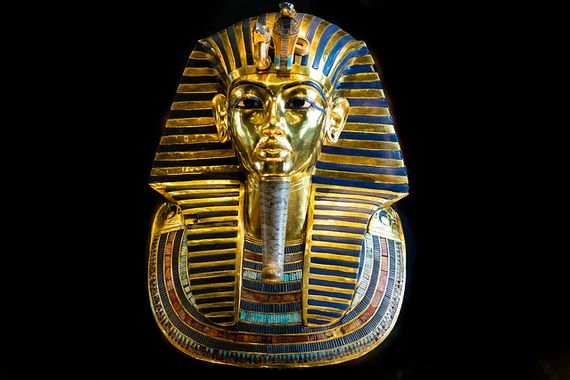That we humans are attracted to legends of curses is something that cannot be denied, and if they are surrounded by the mystery of ancient Egypt, better still. But if one curse reigns over the others, it is undoubtedly that of the pharaoh Tutankhamen, whom popular myth blamed for the death of Lord Carnarvon (April 5, 1923), the financial backer of the excavation of his tomb. Naturally, when science comes into play, the spell is broken, and the spirits are transformed into an infection caused by certain fungi that slept the sleep of centuries in the silence of the tomb.
This version of Lord Carnarvon’s death has been spread to such an extent that today many believe it to be true. But is it? As curious as it may seem, the truth is that today the history of the fungal infection also contains more rumour than fact. Not only has it never been scientifically proven, in reality it never even arose with the pretence of being a true hypothesis.

The tomb of Tutankhamen was discovered in November 1922 by Howard Carter, the archaeologist hired by George Herbert, 5th Earl of Carnarvon, an amateur Egyptologist who financed the excavation. Five months later, Carnarvon died in Cairo. His premature death at age 56 was officially attributed to “pneumonia supervening on erisipelas,” skin infections caused by streptococcus. It was said that he had cut a mosquito bite on his cheek while shaving, and that the resulting infection had invaded his body. The count was in poor health following a car accident in 1903 that had nearly cost him his life, and he often suffered from lung infections.
A legend created by Conan Doyle
However, popular imagination soon began to forge a very different version, to which Scottish writer Arthur Conan Doyle, creator of Sherlock Holmes, made a decisive contribution. Although his famous character was known for his scrupulous reasoning and scientific empiricism, Doyle was a great believer in spiritualism. According to the press of the time, the famous author blamed Carnarvon’s death on an “evil elemental” that guarded the tomb and had avenged its profaners. Thus, the curse of the mummy soon became a legend in the hand of Conan Doyle.
But ghosts were not the only elements that became part of Tutankhamun’s curse. The British novelist Marie Corelli wrote a letter to the New York World in which she claimed to know of certain ancient texts that spoke of poisons deposited in Egyptian tombs to kill those who desecrated them. And although both Egyptologists and doctors dismissed the theory of poison as pure fantasy, a consulted pathologist contributed another hypothesis: germs. “One germ would be sufficient to cause a fatal infection,” quoted The Sunday Times in Australia on June 3, 1923.

Thus, the infectious version of Tutankhamen’s curse is not a recent idea, but arose immediately after Lord Carnarvon’s death. But its journey has been long: if one consults certain sources, such as an article published in 1998 in the Canadian Medical Association Journal, one would say that the idea emerged in that same year after French researcher Sylvain Gandon published a study in which he proposed the spores of a fungus that slept in the sepulchre of the pharaoh as the cause of the infection that rapidly led the Earl to his own tomb.
However, it wasn’t like that. Gandon’s research at the Centre for Functional and Evolutionary Ecology in France covers the evolutionary epidemiology of infectious diseases; in other words, how pathogens relate to their environment over time and how this influences their virulence. In 1998 Gandon published a study in Proceedings of the Royal Society B entitled “The curse of the pharaoh hypothesis” in which he wrote: “The mysterious death of Lord Carnarvon after entering the tomb of the Egyptian pharaoh Tutankhamen could potentially be explained by an infection with a highly virulent and very long-lived pathogen.” Now, does this mean that Gandon points to this factor as the true cause of the Earl’s death? “Not really,” the researcher tells OpenMind.
The sit and wait hypothesis
This requires an explanation. According to what evolutionary biologist at Oxford University Charlotte Rafaluk-Mohr explained to OpenMind, in the 1980s Paul W. Ewald proposed that infectious agents capable of surviving for a long time outside a host might increase their virulence. In general, it is not useful for a parasite to be too lethal because when the host dies, so does the pathogen itself; as the saying goes, dead dogs don’t bite. However, those that persist in the environment in the form of spores or other resistant phases may find an advantage in increasing their lethality. “It was initially called the sit and wait hypothesis,” Rafaluk-Mohr says.

But in 1996, a study carried out by three epidemiologists renamed the sit and wait hypothesis by a much catchier name: the curse of the pharaoh. According to Gandon, who then adopted this name in his own study, “The mysterious death of Lord Carnarvon was used as a metaphor to introduce the problem of virulence evolution.” In other words, in reality the hypothesis of the curse of the pharaoh has as much relation to the death of Lord Carnarvon as the famous problem of Schrödinger’s cat to the behaviour of felines; it is only a metaphor.
All of which has not prevented the legend from lasting, as shown by a discussion on the subject in 2003 in the medical journal The Lancet. But for Rafaluk-Mohr, author of a recent study that supports in certain cases the hypothesis of the curse of the pharaoh, the idea of infection “is minimally plausible as an explanation for Lord Carnarvon’s death.” “As far as I know, I can think of no parasite or spore-forming pathogen that infects humans and fits Lord Carnarvon’s description of symptoms, although from an evolutionary ecology perspective it is not impossible to imagine that it could exist.” And from the perspective of the human fascination with curses, even less so.
Comments on this publication